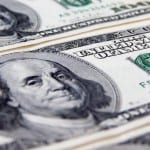Dividend Definitions – What is Dividend Payout Ratio?
By: Ned Piplovic,

A dividend payout ratio is a financial measure that investors use to see what share of earnings an equity returns to its shareholders as dividends.
Next to the dividend yield, the dividend payout ratio is probably the second most used dividend metric that investors consider when analyzing dividend-paying equities. While the dividend yield communicates the current return on investment, the dividend payout ratio lets investors know what portion of its earnings – or assets in case of certain equity types – companies return to investors as dividends and what portion the companies retain to use to increase cash reserves, invest in expansion of their business, pay down debts, etc.
The most obvious function of the dividend payout ratio is that it indicates whether the company is likely to sustain its current dividend payout level or whether it might be in danger of potentially decreasing its dividend payout amount – eliminating the dividend distribution outright in some instances.
What is a desirable dividend payout ratio?
Investors seek equities that pay out a fair portion of their earnings as dividends. However, that payout ratio should not be too high to endanger the longevity of dividend distributions. While there is no exact formula for a desirable ratio, investors generally seek a payout ratio between 30% and 50%. At those levels, the equities return a sizable amount of earnings or assets to provide a meaningful dividend income stream and still retain enough excess profits to expand business operations and ensure growth and stable dividend income over extended time horizons.
A payout of less than 30% indicates that the company is retaining most of its profits, which might be a positive or a negative sign depending on how the company spends those funds. Additional spending towards expanding capacity to meet higher demand for the company’s products, services or development of new products and revenue streams can increase future revenues and profits, which can spur higher dividend payouts in the future. In this case, investors must estimate their opportunity cost and decide whether the lower current dividend is a worthy tradeoff for increased future income or should investors invest in alternative investments with higher returns.
One thing that investors like even more than stable dividend income distributions are rising dividend payouts. Payout ratios that exceed 50% are getting into the area where distributing too much of the company’s earnings can jeopardize rising dividends. Investors can overlook a high payout ratio if a company’s ratio spikes for one or two periods because of low profits or some other market anomaly. However, a high payout ratio over extended periods could signal the inability of the company to support its dividend hikes, which could be first step to dividend cuts.
Exceptions to the payout level target rule
A payout ratio that approaches the 100% mark – and especially after it exceeds 100% – indicates that the equity is using almost all its earnings or more to cover its dividend payouts, which might not leave enough funds for business expansion and other financing activities.
However, every payout ratio increase towards the 100% mark is not necessarily a cause for investor panic and divestiture from the equity. Analysis of the equities’ past payout ratios or business trends might reveal a cyclical nature of the business or the entire industry. If that indeed is the case, comparing the payout ratio to the same period in previous years – instead of the preceding period – can offer a better assessment and more accurate analysis of future dividend payout levels.
Additionally, most companies should have enough reserves and alternative sources to fund dividend distributions through financial difficulties for several quarters – or even a couple of years. However, companies usually try to keep dividend cuts as the tool of last resort because investors generally see dividend cuts as signs of financial trouble or poor management, which lead to stock sell-offs and share-price declines.
To sidestep conveying these negative signals to investors, management generally seeks out alternative solutions to fund the dividend payout, even if it means borrowing funds over the short term. Therefore, a dividend cut is generally a clear signal that the equity has cash flow problems or trouble raising short-term debt. In that case, shareholders would be well advised to analyze their investment closely and even consider liquidating the position.
High payout ratio can be a positive factor
Investors also should know that some equity types have a high payout ratio by design or even legal requirement. For instance, REITs can achieve a preferential tax status and lower tax rates on the dividend distributions. However, to qualify for and retain that favorable tax status, REITs “must distribute at least 90 percent of their taxable income to shareholders annually in the form of dividends.”
Master Limited Partnerships (MLPs) are another equity class with high payout ratios. MLPs generally do not pay any taxes at the federal level and pass through all taxation to the individual partner level. This feature is extremely beneficial as it avoids double-taxation that occurs for dividend payouts. However, to maintain this tax status, at least 90% of the MLP’s income must be qualifying income, which is generally defined as income realized from specific business operations.
The downside of this requirement is that it limits significantly the number of sectors where MLPs can operate – such as real estate and exploration, production or transportation of natural resources. In addition to the high payout ratios, REITs and MLPs also tend to have high dividend yields. However, the share-price performance of these equities can be highly cyclical, with long cycles. Therefore, the benefit of a higher-than-average dividend income can be easily erased by the asset depreciation if investors enter a stock position early in the share price’s downtrend.
Equity’s Maturity
Investors also must consider the equity’s maturity when evaluating the payout ratio. New companies and startups channel all their excess profits – if any – into expanding and building the business. Therefore, these types of companies will generally not pay any dividends or just a marginal amount. Additionally, companies in some sectors – such as the Technology sector – will direct most of their funds into research and development. Therefore, companies in this sector generally pay minimal dividends, if any.
Alternatively, companies that are further along on the maturity scale are much better candidates for significant dividends with increasing payout amounts over extended periods. Some companies have records of consecutive annual hikes that span decades. Currently, a group of 52 S&P 500 companies with market capitalization of more than $3 billion called the Dividend Aristocrats have records of boosting their respective annual dividend amounts for at least the past 25 consecutive years. An even more exclusive group of just 16 of these companies – Dividend Kings – have boosted their annual dividends 50 years or more.
Please note that – like the dividend yield – the dividend payout ratio is just one dividend measure that investors should evaluate in conjunction with other financial metrics. Just like a sudden payout ratio spike could be temporary and no cause for concern, an equity might be in potential trouble even if the dividend payout ratio is well below 100%. A sudden stop of dividend hikes, after a long consecutive streak, could be an early warning sign of potential trouble.
Investors seeking steadily rising dividend income over the long term should use the dividend payout ratio as one of the tools in their analysis toolbox to identify equities that distribute a fair amount of their earnings to yield significant dividend income without jeopardizing long-term payouts and dividend hikes.
Dividend increases and dividend decreases, new dividend announcements, dividend suspensions and other dividend changes occur daily. To make sure you don’t miss any important announcements, sign up for our E-mail Alerts. Let us do the hard work of gathering the data and sending the relevant information directly to your inbox.
In addition to E-mail Alerts, you will have access to our powerful dividend research tools. Take a quick video tour of the tools suite.








 Connect with Ned Piplovic
Connect with Ned Piplovic
